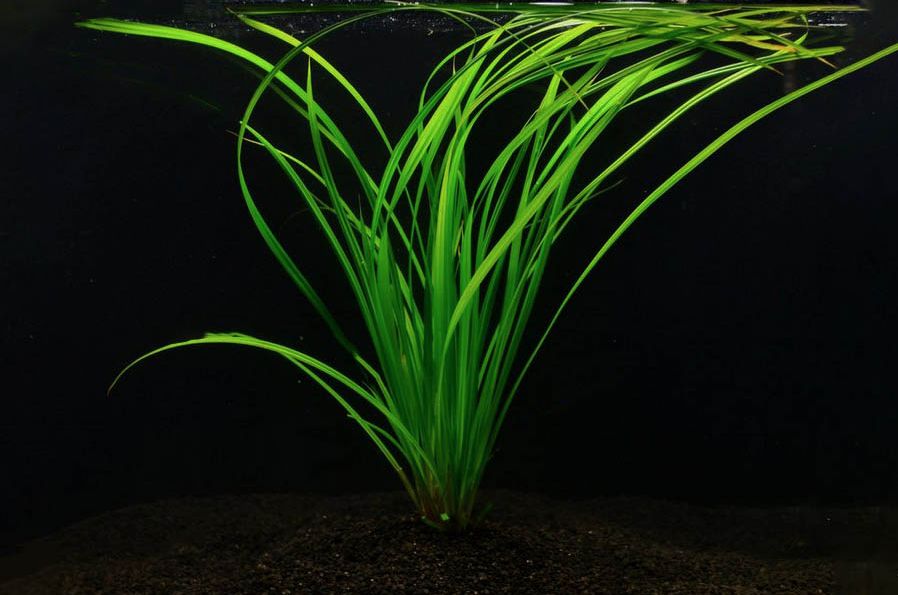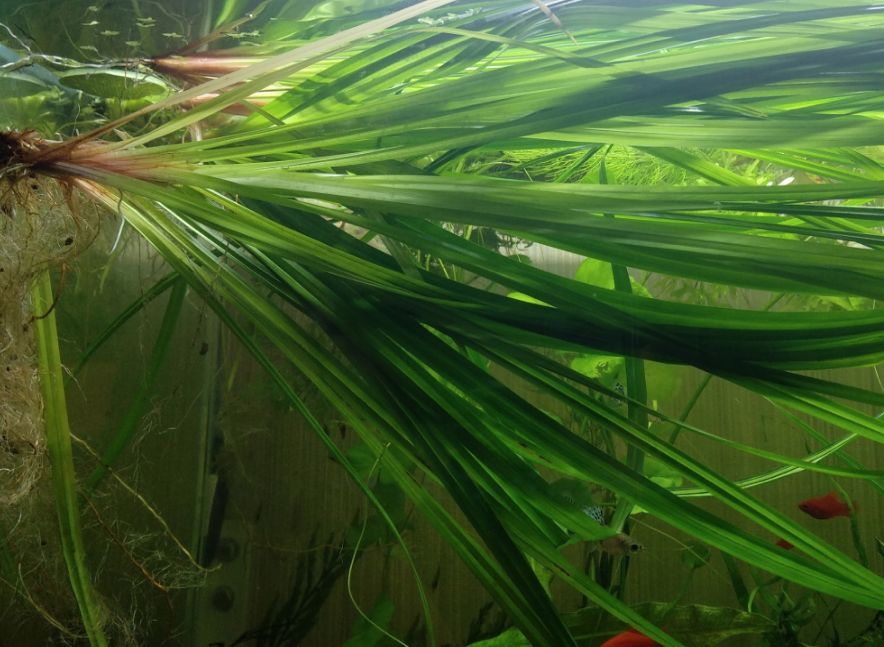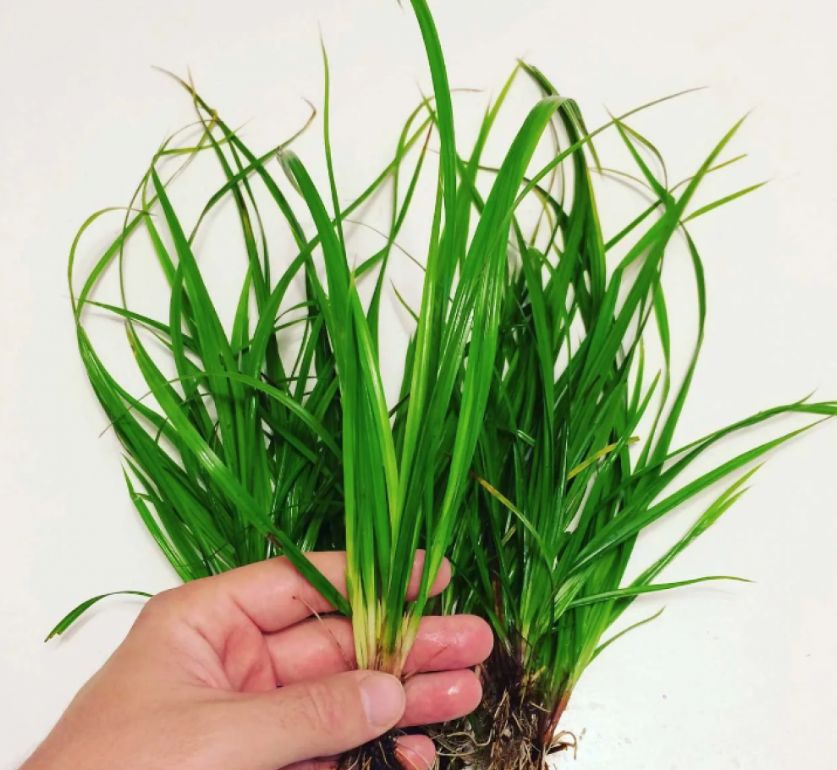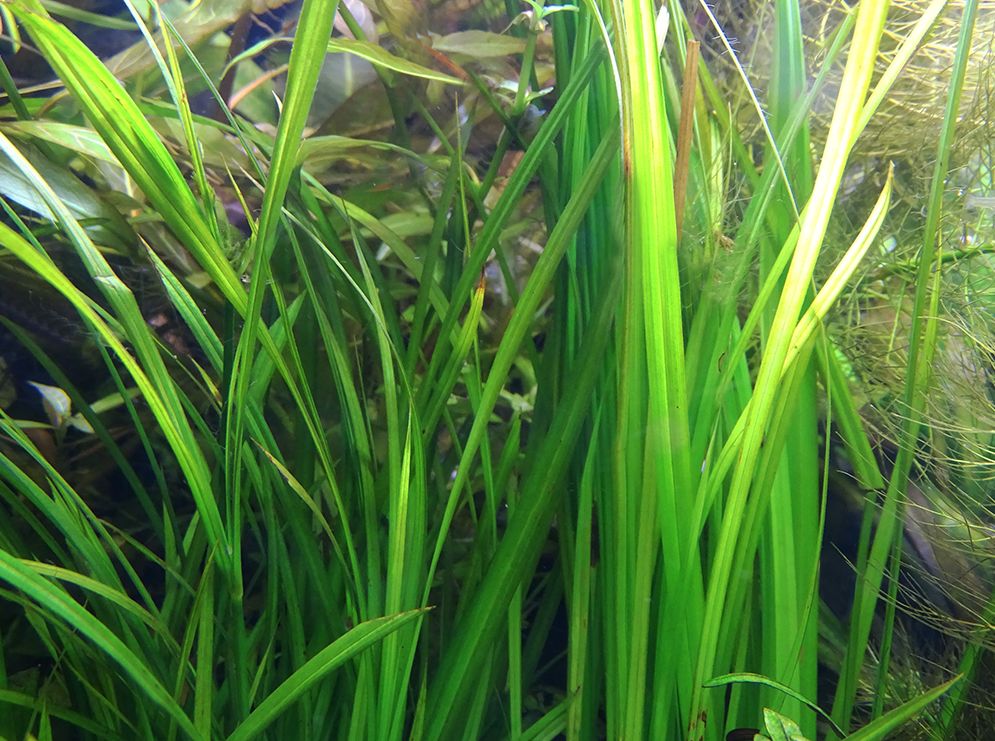Cyperus helferi is one of those few plants, which actually are not aquatic ones, but they adapt quite well to dwelling in tanks. The plant is a rather popular one and not very challenging to keep. Native to Thailand, this plant features long, thin, and vibrant green leaves that grow in a circular pattern, resembling an dwarf papyrus.

Contents
Habitat in the wild
In the wild this species is encountered in South-East Asia. Its natural habitat is in slough waters with lentic or slowly flowing water. Cyperus kind has more than 900 species, among which you can find a renowned house plant and a well known papyrus – this is the plant used in ancient Egypt to make the same-name paper.
Description
Cyperus helferi has elongated narrow leaves growing from one center – their rosette. Each bush can grow up to 50 leaves. Cyperus helferi typically reaches a height of 20-35 cm (8-14 inches) when fully grown. The leaves can vary in length, with some reaching up to 40 cm (16 inches) long and the leaf width can be 5-7 mm. The plant forms dense clusters of foliage, providing both visual appeal and an excellent hiding place for small fish and invertebrates. The root system is weak and it can’t withstand strong water flow or attempts of large fish to tear the plant from the substrate.
| Aspect | Cyperus helferi |
|---|---|
| Common Name | Umbrella papyrus; dwarf papyrus |
| Origin | Thailand |
| Growth Rate | Moderate |
| Maximum Height | 20-35 cm (8-14 inches) |
| Leaf Description | Long, slender, vibrant green leaves |
| Lighting Requirement | Moderate to high |
| Temperature Range | 22-28°C (72-82°F) |
| pH Range | 6.0-7.5 |
| Water Hardness | Tolerates a wide range |
| Nutrient Demands | High |
| CO2 Requirement | Beneficial, but can grow without supplementation |
| Placement | Foreground or midground |
| Aquascape Use | Adds depth and texture to the design |
| Maintenance | Regular trimming may be required |
| Difficulty Level | Intermediate |
Difficulties in keeping
Cyperus helferi is one of the plants of medium difficulty in keeping. We can’t call it a demanding one, however long term adaptation to new conditions is peculiar to this plant. If there is low content of nutrients in the substrate or tank water, cyperus won’t suffer much, but it won’t demonstrate essential growth rate either.
Provided with abundance of macro- and microelements cyperus shows stable growth pace. Just like for other tank plants, additional CO2 supply increases this parameter.

Cyperus helferi vs vallisneria
Both Cyperus helferi and Vallisneria are beautiful aquatic plants that can enhance the aesthetics of an aquarium. The choice between them depends on the desired appearance, growth habit, and lighting conditions of your aquarium, as well as your experience level as an aquarist.
Here’s a comparison between Cyperus helferi and Vallisneria, two popular aquatic plants:
- Appearance:
- Cyperus helferi: It has long, slender leaves that grow in a spiral pattern, resembling umbrellas or palm trees. The leaves are vibrant green and create an elegant and visually striking display in the aquarium.
- Vallisneria: It features long, ribbon-like leaves that are typically green but can have variations in color and patterns depending on the species. The leaves are often narrow and grass-like.
- Growth Pattern:
- Cyperus helferi: It forms dense clusters of foliage, with leaves growing upright and slightly arching. The plant can reach a height of 20-35 cm (8-14 inches) when fully grown.
- Vallisneria: It typically forms long, slender leaves that can grow tall, ranging from a few inches to several feet in height, depending on the species. The leaves can grow vertically or spread horizontally across the water surface.
- Light Requirements:
- Cyperus helferi: It requires moderate to high lighting levels to thrive and maintain its vibrant appearance. Adequate lighting is essential for photosynthesis and promoting healthy growth.
- Vallisneria: It is a versatile plant that can tolerate a wide range of lighting conditions, from low to high. However, moderate to high lighting is recommended for optimal growth and leaf coloration.
- Care Level:
- Cyperus helferi: It is considered an intermediate-level plant. While it has specific lighting and nutrient requirements, with proper care, it can be successfully cultivated in a well-maintained aquarium.
- Vallisneria: It is generally considered an easy-to-moderate level plant, suitable for beginners. It is hardy and can adapt to various water conditions, making it a popular choice for aquarists of all experience levels.
- Aquascape Placement:
- Cyperus helferi: It is often used as a foreground or midground plant in aquascaping. Its long, graceful leaves add depth and texture to the overall design.
- Vallisneria: It is commonly used as a background or midground plant due to its tall growth and spreading leaves. It creates a natural and lush backdrop in the aquarium.

Care and keeping in a tank
Water parameters
The plant is quite widespread and isn’t a challenging one to keep. Water in a tank shouldn’t be too warm, since optimal water temperature for the plant is about 22-28°C (72-82°F). Water acidity should be slightly acidic to neutral pH levels of 6.0-7.5. It can tolerate a wide range of water hardness levels. Dwarf papyrus is less demanding in terms of water hardness, therefore it grows well both in soft and medium hardness water. It successfully dwells in tanks with water filtrated by means of reversed osmose membrane.
Due to low growth rate of cyperus helferi there is a high chance that algae will appear on its leaves. That’s why proper biofiltration of tank water should be organized as well as regular control of ammonia level in the tank water.
CO2
CO2 supply effectively stimulates the plant development rate, however, CO2 supply isn’t a must for it. Supplying essential macro and micronutrients, as well as carbon dioxide (CO2) supplementation, can promote optimal growth and ensure its long-term health

Lighting
The main condition of successful keeping in a tank is good lighting. Cyperus helferi requires moderate to high lighting levels to thrive and maintain its vibrant appearance. Adequate lighting is essential for photosynthesis, which is crucial for the plant’s growth and overall health.
Ensure that the lighting duration is consistent and ranges from 8 to 10 hours per day. Providing a photoperiod that mimics a natural day-night cycle helps maintain a stable environment for the plant and promotes healthy growth.
Keep in mind that too much or too little light can negatively impact Cyperus helferi. Insufficient light can lead to weak growth and a loss of vibrant coloration. On the other hand, excessive light intensity can cause algae issues and may result in leaf burn or bleaching. It’s crucial to find the right balance for your specific setup.
Substrate
Small grained nutritious substrate rich with nitrates, phosphates, potassium and other nutrients is desirable for the plant. If the substrate isn’t nutritious enough you’ll have to introduce additional fertilization. Adding ground fertilizers or clay balls under roots is good for the plant growth pace.
Propagation
It’s better to cut off cyperus leaves that reach the water surface (trimming near their very bottom). If you just trim the leaf with scissors, it will stop growing further and, as a rule, in time it gets yellow and dies. Cyperus helferi is usually put in the middle plan and surrounded with shorter plants. Also it can be used to decorate backside of small planted tanks or when creating pathways under water.
Attractive shape of the leaves as well as their bushy form allows obtaining a fluffy bush in a very short time. Such a bush will eye-catchingly stand out against other tank plants.
Sources: